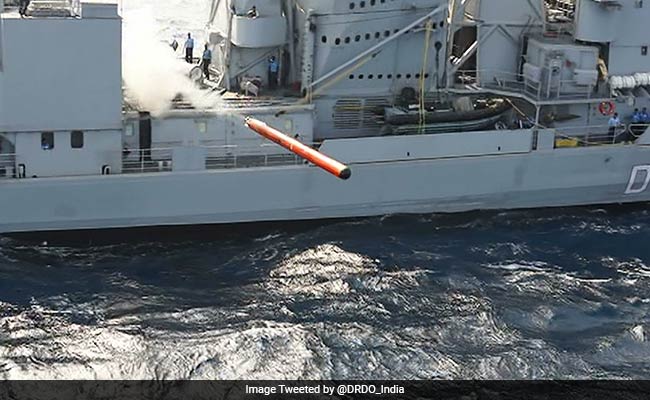Monthly Archives: January 2025
SOURCE: AFI


In a significant stride towards enhancing India’s naval capabilities, the Defence Research and Development Organisation (DRDO) has developed the Electronic Heavy Weight Torpedo (EHWT), a cutting-edge weapon system designed to bolster the Indian Navy’s underwater combat prowess. This development marks a pivotal moment in India’s defense autonomy, aligning with the national vision of ‘Aatmanirbhar Bharat’ or self-reliant India.
The EHWT is an advanced, submarine-launched anti-submarine warfare (ASW) torpedo. It is an evolution of the previously inducted Varunastra torpedo, tailored specifically for submarine deployment. This torpedo is designed to engage quiet submarines effectively in both shallow and deep waters, showcasing a blend of high precision and significant range capabilities.
Continue readingSOURCE: IDRW.ORG

As anticipation builds around the announcement of the winner for India’s Project-75I submarine tender, the program might soon face legal hurdles due to non-compliance with the Air Independent Propulsion (AIP) system standards specified in the Request for Proposal (RFP) by the Indian Navy.
The tender pits Germany’s ThyssenKrupp Marine Systems (TKMS) with its U-214NG submarine against Spain’s Navantia, which offers the S-80 class. Both contenders have showcased their AIP systems but in ways that have raised questions about adherence to the Navy’s technical requirements.
Continue readingSOURCE: IDRW.ORG


In a move to enhance its operational capabilities in desert and semi-desert environments, the Indian Army has issued a Request for Proposal (RFP) for the procurement of 10,276 Multi-Spectral Camouflage Nets (MSCN). This procurement is aimed at equipping critical military assets like tanks and radars with state-of-the-art camouflage technology to evade enemy detection across multiple electromagnetic (EM) spectrum ranges.
The MSCNs are specifically intended to provide multi-spectral concealment for critical military assets when operating in hostile environments. These nets are designed to safeguard equipment by minimizing their detectability from enemy surveillance systems, ensuring a tactical advantage in both offensive and defensive operations.
Continue readingSOURCE: AFI

Amidst global trends towards sixth-generation combat aircraft, the Aeronautical Development Agency (ADA) team behind the Tejas MkII program has robustly defended the continued development of this 4.5+ generation platform. Critics questioning the relevance of the Tejas MkII in an era eyeing future technologies have met with a well-structured argument from the ADA, emphasizing strategic foresight and technological continuity.
The Tejas MkII, or LCA Mk2, is not merely another fighter jet but a crucial stepping stone in the evolution of India’s indigenous aircraft design. It builds upon the lessons and technologies developed during the LCA Mk1 program, offering a platform to refine and innovate before leaping into more advanced systems.
Continue readingSOURCE: AFI


In a strategic move to safeguard its burgeoning space assets, Pakistan has reportedly initiated discussions with China to acquire Anti-Satellite (ASAT) missiles. This development comes in the wake of India’s successful ASAT test, known as Mission Shakti, which demonstrated India’s capability to neutralize satellites in low Earth orbit, thereby posing a potential threat to Pakistan’s space infrastructure.
Pakistan’s space program, while not as extensive as India’s or China’s, has been making steady progress, focusing on both civilian and military applications. Satellites are becoming central to Pakistan’s strategic operations, including communication, reconnaissance, and navigation. The country currently operates several satellites, with the most notable being the PakSat-1R for telecommunications and the PRSS-1 (Pakistan Remote Sensing Satellite) for earth observation, which are crucial for both civilian and defense sectors.
Continue readingSOURCE: AFI


India’s decision to withdraw from the Fifth Generation Fighter Aircraft (FGFA) program with Russia has often been attributed to concerns over the aircraft’s technical shortcomings, including its limited stealth capabilities. However, the financial burden of the project appears to have been the decisive factor in India’s pullout.
The FGFA program, based on Russia’s PAK-FA or Sukhoi T-50 platform, was initially envisioned as a joint venture with a 50:50 design and work-share agreement. This collaboration promised India a stake in the development of a cutting-edge stealth fighter. However, as the program progressed, India’s participation became increasingly limited, with Russia retaining much of the design and development work.
Continue readingSOURCE: AFI


The Ministry of Defence (MoD) in India has embarked on three ambitious projects aimed at enhancing the operational capabilities of its armed forces through the integration of surveillance radars and sensors. These initiatives are designed to provide real-time, actionable intelligence for both offensive and defensive military operations across the Indian Air Force (IAF), Army, and Navy.
For the IAF, the focus is on creating a comprehensive ‘composite picture’ of the airspace through the integration of all national air surveillance radars. This integration will occur within the framework of the Integrated Air Command and Control System (IACCS). The IACCS is not just a collection of hardware but an advanced software platform that automates the command and control processes essential for air operations.
Continue readingSOURCE: AFI


From December 19 to 22, 2024, Hanoi hosted the Vietnam International Defence Expo, where Indian defense enterprises made a significant impact. Bharat Electronics Limited (BEL), Hindustan Aeronautics Limited (HAL), Bharat Dynamics Limited (BDL), Mazagon Dock Shipbuilders Limited (MDL), Defence Research and Development Organisation (DRDO), Larsen & Toubro (L&T), Neo Power, BrahMos Aerospace, and Runflat Tyre Systems were among the key participants, drawing considerable attention and fostering discussions on future Indo-Vietnamese defense collaborations.
Continue readingSOURCE: RAUNAK KUNDE / NEWS BEAT / IDRW.ORG


Larsen & Toubro (L&T), in collaboration with the Defence Research and Development Organisation (DRDO), has begun manufacturing the second prototype of the Zorawar Light Tank, marking a significant stride in India’s indigenous defense capabilities. This development comes as the Indian Army gears up to conduct extensive trials on the first prototype of this new light tank, designed specifically for high-altitude warfare.
The second prototype’s manufacturing signifies an acceleration in the development process, providing the army with an opportunity to compare and refine the tank’s design based on feedback from the ongoing trials. The Indian Army has expressed intentions to induct up to 354 units of this tank, highlighting its strategic importance in modernizing the country’s armored forces for operations in rugged and high-altitude areas where traditional heavy tanks struggle.
Continue readingSOURCE: RAUNAK KUNDE / NEWS BEAT / IDRW.ORG


A senior Indian Air Force (IAF) official, speaking to idrw.org on the condition of anonymity, has shed light on the delayed timeline for the Su-57E, the export variant of Russia’s fifth-generation stealth fighter. The official stated that the Su-57E equipped with the latest AL-51F engine and 2D Thrust Vector Control (TVC) nozzles is at least 4–5 years away from production readiness.
Russia has showcased the Su-57E with a stealth engine casing and other enhancements, but it remains unclear if the export version offered to India would include these upgrades. Even if these features are incorporated, the production timeline for such a variant would extend well into the latter half of this decade.
Continue readingSOURCE: RAUNAK KUNDE / NEWS BEAT / IDRW.ORG


The next-generation BrahMos-NG missile, currently under development, is slated to enter its trial phase by late 2027 or early 2028, according to an official closely associated with idrw.org. This advancement marks a significant step in enhancing India’s aerial strike capabilities with a missile designed for versatility across various fighter jet platforms, including smaller aircraft.
The official revealed to idrw.org that “the project is progressing smoothly. The design blueprint for the new missile has been finalized, and we are now moving towards the development phase.” This phase will see BrahMos Aerospace conducting captive flight trials starting in 2026. “If integration and these captive flight trials are concluded smoothly, then the first developmental test firing could take place by 2027,” the source added.
Continue readingSOURCE: AFI


The Defence Research and Development Organisation (DRDO) is making significant strides in unmanned aerial technology with the development of a High Altitude Long Endurance (HALE) Unmanned Aerial Vehicle (UAV) specifically designed for Intelligence, Surveillance, Target Acquisition, and Reconnaissance (ISTAR) roles. This new UAV is poised to enhance India’s aerial surveillance capabilities with its advanced specifications.
The UAV is designed to be a 5-tonne platform, making it robust enough to carry substantial equipment for various mission profiles. It will have a payload capacity of 2 tonnes, allowing it to be equipped with a variety of sensors, cameras, and potentially offensive capabilities for ISTAR missions.
Continue readingSOURCE: AFI


The Gas Turbine Research Establishment (GTRE) under India’s Defence Research and Development Organisation (DRDO) is pushing forward with the development of the Kaveri Derivative Engine (KDE), also known as the Kaveri Dry non-afterburning engine. This engine version produces 46 kN of thrust (IRA SLS – International Reference Atmosphere Sea Level Static) but comes with a substantial weight of up to 1180 kg, which is on the heavier side for engines in its class, even without an afterburner.
The KDE’s weight is particularly notable because, even without the additional mass of an afterburner section, it matches or exceeds that of some engines equipped with afterburners. This discrepancy could limit its application in manned fighter jets where weight-to-thrust ratio is critical for performance.
Continue readingSOURCE: AFI


Shiva Texyarn Ltd, a well-established name in the textile industry, has clinched a significant contract from the Department of Military Affairs for the supply of 16,000 pairs of Nuclear, Biological, and Chemical (NBC) Suits, specifically the Permeable MK V model. This deal marks a notable achievement for the company, reflecting its prowess in producing high-quality protective gear that adheres to the rigorous standards of the Indian Armed Forces.
The Permeable MK V suits are engineered to meet the stringent standards required for modern defense operations. These suits are lightweight, durable, and capable of offering extended protection in extreme environments. Shiva Texyarn’s ability to meet these rigorous specifications highlights its manufacturing prowess and its commitment to supporting India’s defense preparedness.
Continue readingSOURCE: IDRW.ORG


The Indian Navy’s commitment to enhancing its naval capabilities is evident with the significant upgrades to the new batch of Talwar Class frigates. These upgrades include the introduction of the A-192M Naval Gun and a shift from the twin-arm launcher to a Vertical Launch System (VLS) for the Shtil-1 Air Defense (AD) system, marking a substantial leap in both offensive and defensive prowess.
Replacing the previous A-190E, the A-192M Naval Gun is a notable upgrade. This gun, which is also employed on Russia’s Admiral Gorshkov-class frigates, promises improved range, accuracy, and firing rates. The A-192M is designed to tackle both surface and aerial threats effectively, with an emphasis on reducing the ship’s radar signature through its stealth-friendly design. This upgrade not only increases the lethality of the Talwar Class frigates but also aligns them with modern naval combat requirements, where the ability to engage multiple types of targets at extended ranges is crucial.
Continue reading